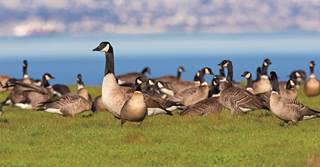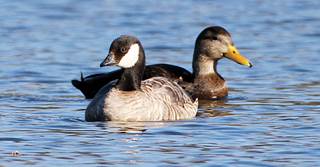Understanding Waterfowl: A Closer Look at Cacklers
These small arctic-nesting geese are among North America’s most interesting waterfowl
These small arctic-nesting geese are among North America’s most interesting waterfowl
By Kelly Warren
In waterfowl hunting vernacular, the term "cackler" is often used to describe any of the small white-cheeked geese that produce the high-pitched calls for which they are named, in contrast to the guttural honks of larger Canada geese. These birds were once classified as Canada geese, but in 2004 the American Ornithological Society (AOS) reclassified the four smallest subspecies of Canada geese as members of a new species known as the cackling goose (Branta hutchinsii). Today, four subspecies of cackling geese are recognized by the AOS: cackling (minima), Aleutian (leucopareia), Richardson's (hutchinsii), and Taverner's (taverneri). All four subspecies largely breed on the treeless tundra of Alaska and northern Canada. With the exception of the Richardson's subspecies, cacklers are found almost exclusively in the Pacific Flyway.
Just how small are these geese? The smallest subspecies (minima) is only slightly larger than a mallard when fully grown. Formerly known as the cackling Canada goose, this diminutive bird has a conspicuously short neck and stubby bill. Adults have dark brown plumage on their chest, which is often accompanied by a white neck ring that can vary in size. At a distance, they can be distinguished from larger geese by their rapid wing beats.
These birds nest in western Alaska along the coast, mainly on the Yukon-Kuskokwim Delta. Their numbers declined significantly from about 400,000 birds in the late 1960s to fewer than 25,000 in the mid-1980s. Harvest restrictions and other management agreements helped the population rebound during the 1990s. However, like other arctic-nesting geese, their reproductive success is heavily dependent on the quality of foraging habitat on their wintering grounds and spring weather conditions on their breeding grounds. Nearly the entire population once wintered in the Central Valley of California, but starting in the mid-1990s they expanded their wintering range north into northwest Oregon, Washington, and occasionally British Columbia. In 2022, an estimated 238,000 minima cackling geese were surveyed in Alaska, a 15 percent increase from the previous year's estimate but slightly below the management goal of 250,000 birds.

Cackling geese, which were once classified as Canada geese but are now recognized as a separate species, can be easily distinguished from their larger relatives by their small size, short necks, and stubby bills. Aleutian geese (in foreground) were once threatened with extinction but have made a dramatic recovery in recent decades. Photo © Michael Peters
Next in size is the Aleutian goose, which is named for its primary breeding grounds along the Aleutian Islands off southwestern Alaska. These birds are slightly larger than minima, and they have lighter breast feathers and a prominent white neck ring accompanied by a narrower, darker ring that fades into the chest. Another notable characteristic is their white cheek patches, which often do not connect under the chin. Most Aleutian geese winter along the Pacific coast from southwestern Washington to central California. The population estimate in 2022 was 215,000 birds, an 18 percent increase from the previous year's estimate.
Numbers of Aleutian geese declined dramatically during the 19th century, after fur traders introduced foxes to the birds' nesting islands. The population dwindled to only a few hundred birds, prompting the US Fish and Wildlife Service to place them on the Endangered Species List in 1967. Recovery efforts eliminated the introduced foxes and relocated geese to many islands throughout their former breeding range. The population made a rapid recovery, and Aleutian geese were removed from the Endangered Species List in 2001. By the winter of 2007minus;2008, the population exceeded 100,000 birds, surpassing the 60,000-bird management goal.
Due to the growth of the population and increasing crop depredation issues caused by the birds, waterfowl managers lifted hunting restrictions on Aleutian geese in Oregon and California, allowing regulated harvest of the birds for the first time in nearly 50 years. Waterfowl managers have since expanded hunting opportunities into February and March and further liberalized bag limits. The successful restoration of the Aleutian goose serves as a model for the recovery of other wildlife species under the Endangered Species Act.

The Richardson's goose is the only cackler subspecies found in the midcontinent region. The remaining three subspecies, including the tiny minima, are found almost exclusively in the Pacific Flyway. Photo © USFWS

The Richardson's goose is the only cackler subspecies found in the midcontinent region (see map). Photo © MichaelFurtman.com
Similar in size to the Aleutian goose, the Richardson's goose, also known as the Hutchinson's goose, is the only cackling goose subspecies that occurs mostly in the Central and Mississippi Flyways. These birds can be distinguished from other cackling geese by their pale gray plumage, which is much lighter than that of their western cousins. Richardson's geese nest across the Canadian Arctic from the Mackenzie River Delta in the Northwest Territories to the east across Nunavut and to the Melville Peninsula north of Hudson Bay, as well as on Victoria, King William, Qikiqtaryuaq (formerly Jenny Lind), Baffin, and Southampton Islands. During migration Richardson's geese are widely distributed throughout the midcontinent region. The majority winter on the Southern High Plains across Kansas, Oklahoma, and Texas. Although survey data are limited, this large population of cackling geese is believed to be stable.
The Taverner's goose is the largest and least studied of the four subspecies. Nesting throughout western Alaska from the Arctic to the western interior and coast, this subspecies prefers slightly more inland nesting areas than minima does. Most Taverner's geese winter in Oregon and Washington, but smaller numbers spend the winter farther south in the Central Valley of California and occasionally in neighboring states. Comprehensive survey data are limited for this subspecies, but available information indicates that the population is stable or increasing. Scientists are currently conducting research to learn more about these birds and help fine-tune their management.
Over the past several decades, the winter distribution of many cackling goose populations has been changing. Although definitive explanations are elusive, these shifts are likely driven by changes in climate, agricultural practices, hunting pressure, and competition with other waterfowl species for limited habitat. One thing is certain: cackling geese will go where they can find the resources they need to conserve energy, maintain body condition throughout the winter, and prepare for successful breeding in the spring. Many populations are also increasing, so these interesting birds may be coming soon to a region near you.
Kelly Warren is a DU regional biologist based in Philomath, Oregon. Kyle Spragens, waterfowl section manager for the Washington Department of Fish and Wildlife, also contributed to this article.
Ducks Unlimited uses cookies to enhance your browsing experience, optimize site functionality, analyze traffic, and deliver personalized advertising through third parties. By continuing to use this site, you agree to our use of cookies. View Privacy Policy